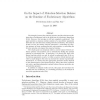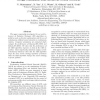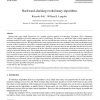131 search results - page 9 / 27 » Evolutionary Neuroestimation of Fitness Functions |
CEC
2003
IEEE
14 years 1 days ago
2003
IEEE
Neural networks and the Kriging method are compared for constructing £tness approximation models in evolutionary optimization algorithms. The two models are applied in an identica...
CORR
2010
Springer
13 years 4 months ago
2010
Springer
The interplay between the mutation operator and the selection mechanism plays a fundamental role in the behaviour of evolutionary algorithms (EAs). However, this interplay is stil...
SEAL
1998
Springer
13 years 11 months ago
1998
Springer
This paper empirically investigates the use and behaviour of Evolution Strategies (ES) algorithms on problems such as function optimisation and the use of evolutionary artificial ...
AI
2006
Springer
13 years 6 months ago
2006
Springer
Starting from some simple observations on a popular selection method in Evolutionary Algorithms (EAs)--tournament selection--we highlight a previously-unknown source of inefficien...
GECCO
2010
Springer
13 years 10 months ago
2010
Springer
Shaping functions can be used in multi-task reinforcement learning (RL) to incorporate knowledge from previously experienced tasks to speed up learning on a new task. So far, rese...



